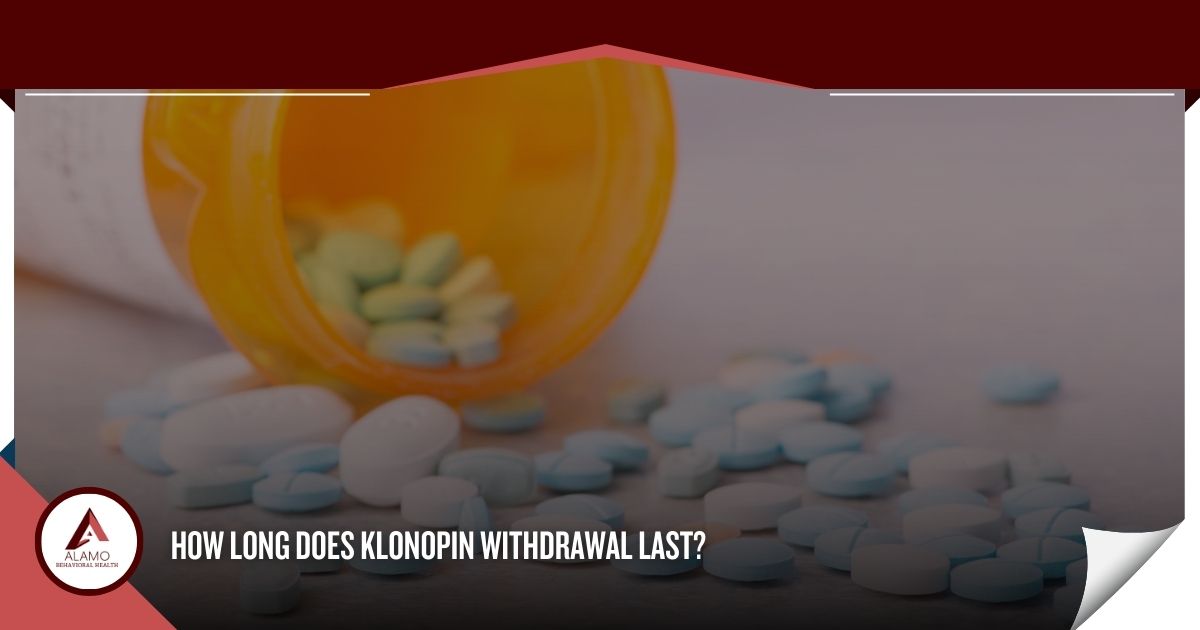Klonopin is the brand name for clonazepam, a benzodiazepine medication used to treat panic disorder and certain types of seizure disorders.[1] While it can help reduce anxiety symptoms and control seizures, it can also be addictive when abused.
Abruptly stopping the use of Klonopin can result in a variety of uncomfortable withdrawal symptoms, such as anxiety, irritability, insomnia, and mood swings. This article discusses what you need to know about Klonopin withdrawal.
What you will learn:
- The symptoms of withdrawal
- How long Klonopin withdrawal lasts
- What to expect in each stage of the withdrawal timeline
- How to cope with withdrawal
Understanding Clonazepam Withdrawal
Benzodiazepines like clonazepam are a class of drugs that work by increasing the reuptake and presence of gamma amino-butyric acid (GABA) in the brain. GABA inhibits or reduces the activity of nerve cells, helping to calm the central nervous system.[2]
After regular use, the brain adapts to the presence of clonazepam by reducing its natural production of GABA. Since clonazepam increases GABA, the brain begins to reduce its own GABA production to maintain balance. Then, when clonazepam is suddenly removed, there is a deficit of GABA in the brain, and the brain can’t make it naturally. GABA normally inhibits or reduces the activity of nerve cells, so this deficit leads to overexcitation of these cells, resulting in symptoms like anxiety and insomnia.
In other words, when someone who is physically dependent stops taking clonazepam suddenly after using it for a prolonged period, the brain may struggle to maintain its balance without the drug’s presence. This imbalance can lead to withdrawal symptoms, which vary in severity depending on factors like dosage, duration of use, and individual physiology.[1,2]
Due to the potential for abuse and dependence, the U.S. Drug Enforcement Administration has designated clonazepam and other benzodiazepines as Schedule IV controlled substances. They can only be obtained legally with a prescription from a licensed practitioner.
Studies have found that about 40% of people who use benzodiazepines longer than six months experience moderate to severe withdrawal symptoms. The remaining 60% still reported mild withdrawal.[3]
How Long Does Klonopin Withdrawal Last?
Clonazepam has a long half-life of 18-50 hours, so it stays in the body for several weeks.[1] As a result, it can take a few days for withdrawal symptoms to appear and several weeks for them to subside.
Acute withdrawal symptoms begin 1-3 days after the last dose, peak within two weeks, and subside within a month. The duration and severity of withdrawal can vary based on several factors, including:
- Length of use
- Frequency of use
- Dosage
- Age
- Weight
- Gender
- Mental health
- Physical health
- Genetics
- Polysubstance abuse
Generally, people who use Klonopin for longer periods, more frequently, and/or at higher doses are more prone to severe and longer-lasting symptoms.
Symptoms of Klonopin Withdrawal
Stopping Klonopin cold turkey is not advised and can be potentially life-threatening. Klonopin withdrawal symptoms include:[4]
- Anxiety
- Panic attacks
- Headaches
- Depression
- Mood swings
- Anger
- Hostility
- Irritability
- Fatigue
- Dizziness
- Confusion
- Insomnia
- Nightmares
- Sleep disturbances
- Muscle spasms
- Stomach pain
- Cramps
- Nausea
- Diarrhea
- Blurry vision
- Tremors
- Sweating
- Hallucinations
- Increased heart rate
- High blood pressure
- Seizures
- Suicidal thoughts
Benzodiazepine withdrawal syndrome is known for causing unpleasant, dangerous, and debilitating physical and psychological symptoms. Hallucinations, confusion, suicidal thoughts, and seizures can all be harmful without prompt medical care.
The Klonopin Withdrawal Timeline
Benzodiazepine withdrawal can be broken down into three phases: early, acute, and protracted or late withdrawal.
Early withdrawal
Early withdrawal symptoms appear 1-3 days after the last dose and last for 2-4 days. Early withdrawal may include “rebound” symptoms, such as insomnia, anxiety, and irritability.
Acute withdrawal
Acute withdrawal peaks around two weeks after the last dose. During acute withdrawal, any of the above-listed symptoms are possible, and there is a high risk of relapse. Acute withdrawal can last for about a month.
Protracted withdrawal
Protracted withdrawal is rare, but it is possible in heavy, long-term benzodiazepine users. Protracted withdrawal is characterized by ongoing psychological symptoms such as anxiety, irritability, depression, mood swings, and sleep disturbances that persist for weeks or months after stopping the drug.
How to Detox Safely & Cope with Withdrawal
Most importantly, you should never attempt to detox from Klonopin by yourself. If you’ve been prescribed Klonopin by your doctor, talk to him or her about reducing your dose gradually to avoid withdrawal symptoms.[5] But if you are addicted to Klonopin, it’s best to seek help from an addiction detox and treatment center near you.
Detox centers provide intensive, around-the-clock care and supervision. They are operated by medical staff including doctors who can prescribe medications, nurses who can monitor your symptoms, and medical assistants who provide supportive care and monitoring.
When it comes to treating benzodiazepine withdrawal, individuals are usually tapered off the drugs slowly. For Klonopin, doctors may prescribe a longer-acting benzodiazepine like Valium (diazepam) and gradually reduce the dose until people are weaned off safely. Tapering can prevent withdrawal complications like seizures.
Medically supervised detox centers may also provide:
- Individual and group therapy
- Physical therapy
- Mental health treatment for co-occurring mental health disorders
- Nutritious meals
- Support groups
- Holistic therapies (e.g. art, yoga, meditation)
- Aftercare planning
During withdrawal, you can take the following steps to make yourself more comfortable:
- Seek support from friends and family
- Stay hydrated
- Eat a healthy, balanced diet
- Stick to a regular sleep schedule
- Engage in healthy distractions
- Attend support group meetings
Safe & Effective Klonopin Detox With Alamo Behavioral Health
If you or a loved one are struggling with Klonopin addiction, please don’t hesitate to get the help that you need. At Alamo Behavioral Health, our medical detox center in San Antonio can ensure your safety and help you cope with the side effects of withdrawal. Our residential treatment programs lay the foundation for lasting recovery.
To learn more about our treatment programs or to get started with a confidential, risk-free assessment, please contact us today.
References:
- National Institute of Health: Clonazepam
- Science Direct: Benzodiazepine Receptor
- British Pharmacological Society: Benzodiazepine dependence and its treatment with low dose flumazenil
- National Institute of Health: The benzodiazepine withdrawal syndrome
- U.S. Food and Drug Administration (FDA): Klonopin







